Looking to add a vibrant touch to your garden? Search no further! I’m here to share my top picks of plants with stunning heart-shaped red leaves. Whether you’re a beginner or an experienced gardener, these plants are sure to captivate you with their beauty. Let me tell you a little story that sets the stage for the main content.
Picture this: It’s a warm summer day, and I’m out exploring a local botanical garden. As I stroll through the vibrant greenery, my eyes catch a glimpse of a dazzling display of heart-shaped red leaves. Mesmerized, I walk closer to get a better look.
There, I discover a plant unlike any I’ve seen before – its foliage is a bright crimson color, shaped like perfect hearts. I’m in awe of its beauty and instantly inspired to bring this captivating plant into my own garden.
Little did I know, this enchanting plant belongs to a group of plants with heart-shaped red leaves, each with its unique characteristics and appeal. From trailing plants to flowering varieties, there’s a heart-shaped plant for every gardener’s taste and style.
In the following sections, I’ll introduce you to some of my favorite heart-shaped red leaf plants, share tips on how to care for them, and provide key takeaways that will help you add a breathtaking touch to your own garden.
Key Takeaways:
- Plants with heart-shaped red leaves bring vibrant beauty to your garden.
- There are various types of heart-shaped red leaf plants, including trailing plants and flowering varieties.
- Proper care and maintenance are essential to ensure the health and longevity of these plants.
- Consider factors such as lighting, watering, and soil type when selecting and caring for heart-shaped red leaf plants.
- With the right care, these plants will provide a charming and eye-catching focal point in your garden.
Arrowhead Plant: A Playful Touch of Red
The arrowhead plant is a popular choice among plant enthusiasts, known for its stunning heart-shaped leaves that come in various shades, including red. With its vibrant foliage, the arrowhead plant adds a playful touch to any indoor space or garden.
When it comes to the red arrowhead plant, one variety that stands out is the Neon Robusta. Featuring pretty pinkish leaves, this particular variety is highly recommended by Juliette Vassilkioti, the founder of My City Plants.
The arrowhead plant, also known by its botanical name Syngonium podophyllum, is a versatile plant that can be grown as a trailing or climbing plant, depending on how you choose to support it. Its heart-shaped leaves create an enchanting display, making it a favorite among plant enthusiasts.
One of the benefits of the arrowhead plant is its adaptability to different light conditions. It thrives in low to medium light environments, making it a great choice for spaces with limited natural light. This low-light tolerance makes it an excellent addition to dimly lit rooms or offices.
Not only is the arrowhead plant visually appealing and easy to care for, but it also makes for a great choice for those looking for a low-maintenance plant. It requires minimal effort to keep this beauty thriving.
Regular pruning is essential to maintain the arrowhead plant’s attractive shape and prevent legginess. By trimming back any excessive growth, you can encourage a bushier and more compact appearance.
Whether you choose to place it on a shelf, use it as a hanging plant, or let it climb upon a moss pole, the arrowhead plant is sure to captivate with its heart-shaped leaves and vibrant red foliage.
The arrowhead plant’s beauty and easy care make it a fantastic addition to any plant collection or indoor space. Its heart-shaped leaves and trailing habit bring a touch of nature’s charm to any corner of your home or office.
String-of-Hearts: Delicate Trailing Beauty
The string-of-hearts is a vining houseplant with delicate heart-shaped leaves that make a charming addition to any space. This trailing plant, also known by its scientific name Ceropegia woodii, features slender vines adorned with small, succulent leaves that resemble the shape of hearts.
What makes the string-of-hearts even more captivating are its dainty pink flowers that bloom sporadically throughout the year. These tiny blooms add an extra touch of beauty to the already enchanting foliage.
To ensure the healthy growth of your string-of-hearts, it’s important to provide it with the right conditions. This plant thrives in low-light environments, making it an ideal choice for rooms with limited natural sunlight. However, it can also tolerate bright, indirect light, so placing it near a window with filtered light is also an option.
In terms of soil, the string-of-hearts prefers well-draining soil to prevent waterlogged roots. A mix of regular potting soil and perlite or coarse sand works well to provide adequate drainage. It’s crucial to allow the soil to dry out slightly between waterings as overwatering can lead to root rot.
While the string-of-hearts is a succulent, it does require a bit more moisture than some other succulent varieties. Misting the leaves regularly can help increase humidity levels and keep the plant thriving. Remember to use room temperature or lukewarm water to avoid shocking the plant.
Due to its trailing nature, the string-of-hearts looks stunning in hanging baskets or placed on high shelves where its vines can cascade down gracefully. It can also be trained to climb up a trellis or indoor support structure, allowing for versatile display options.
The string-of-hearts is a delicate and beautiful trailing plant with heart-shaped leaves and charming pink flowers. Its low-light tolerance and succulent nature make it an excellent choice for plant enthusiasts of all experience levels.
Growing Tips for the String-of-Hearts:
- Provide bright but indirect light or low-light conditions.
- Use well-draining soil to prevent waterlogged roots.
- Allow the soil to dry out between waterings.
- Mist the leaves regularly to increase humidity.
- Consider hanging baskets or climbing structures for attractive displays.
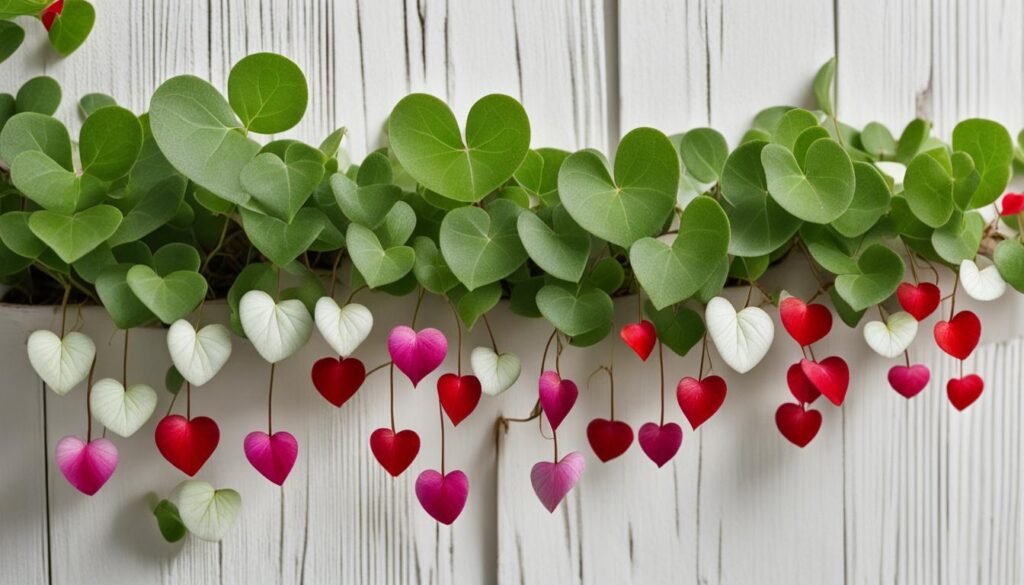
With its delicate trailing vines and heart-shaped leaves, the string-of-hearts brings a touch of elegance and whimsy to any indoor space. Whether it’s adorning a shelf, hanging from a basket, or climbing up a trellis, this low-light succulent is sure to captivate with its unique beauty.
Anthurium: Stunning Blooms and Foliage
Anthuriums are a popular choice for plant enthusiasts, thanks to their stunning heart-shaped leaves and equally beautiful blooms. These flowering plants come in a variety of colors, including white, pink, and red, adding a vibrant touch to any indoor space or garden.
To ensure optimal growth, Juliette Vassilkioti recommends keeping anthuriums in medium light conditions. This means placing them near a window with filtered sunlight or a few feet away from a bright window. This will provide enough light for the plant without exposing it to direct sunlight, which can scorch the leaves. With the right amount of light, anthuriums will thrive and showcase their vibrant foliage.
In terms of care, anthuriums prefer consistently moist soil. It’s important to water them when the top inch of soil feels dry to the touch. However, be careful not to overwater as this can lead to root rot. A well-draining soil mix that retains moisture without becoming waterlogged is ideal for these plants.
Anthuriums make an excellent indoor plant choice, as they are relatively low maintenance and can tolerate a range of humidity levels. However, to promote healthy growth and prevent issues such as pests or diseases, it’s a good idea to provide moderate humidity. This can be achieved by placing the plant on a pebble tray filled with water or occasionally misting the leaves.
With their vibrant foliage and striking blooms, anthuriums serve as a vibrant focal point in any interior display. Whether you choose a classic red variety or opt for a unique color, anthuriums are sure to captivate and enhance the aesthetic appeal of your home.
Did You Know?
Anthracnose, a fungal disease, is a common issue faced by anthurium plants. It typically appears as dark, sunken spots on the leaves and can negatively impact their health. To prevent anthracnose, avoid splashing water onto the foliage, provide adequate air circulation, and ensure the plant is not overcrowded.
Tips for Growing Anthurium
- Place anthuriums in medium light conditions, away from direct sunlight.
- Water the plant when the top inch of soil feels dry to the touch.
- Use a well-draining soil mix to ensure proper moisture levels.
- Provide moderate humidity by misting the leaves or using a pebble tray.
- Keep an eye out for signs of anthracnose and take preventive measures.
Now that you’re familiar with caring for anthuriums, let’s move on to the next stunning plant with heart-shaped leaves on our list – the Monstera.
Monstera: Large Leaves with a Unique Look
The Monstera, also known as the Swiss cheese plant, is a beloved choice among plant enthusiasts for its distinctive appearance and stunning foliage. With its large and fenestrated heart-shaped leaves, the Monstera adds a touch of tropical elegance to any space.
Autumn Hilliard-Knapp from Perfect Plants Nursery advises keeping the Monstera in bright indirect light to ensure optimal growth and leaf development. This plant thrives in environments with moderate humidity, so be sure to provide adequate moisture to keep it healthy and happy.
Regular leaf cleaning is essential for the Monstera, as its glossy leaves can accumulate dust and hinder photosynthesis. Gently wiping the leaves with a damp cloth helps maintain their vibrancy and ensures the plant receives sufficient light for photosynthesis.
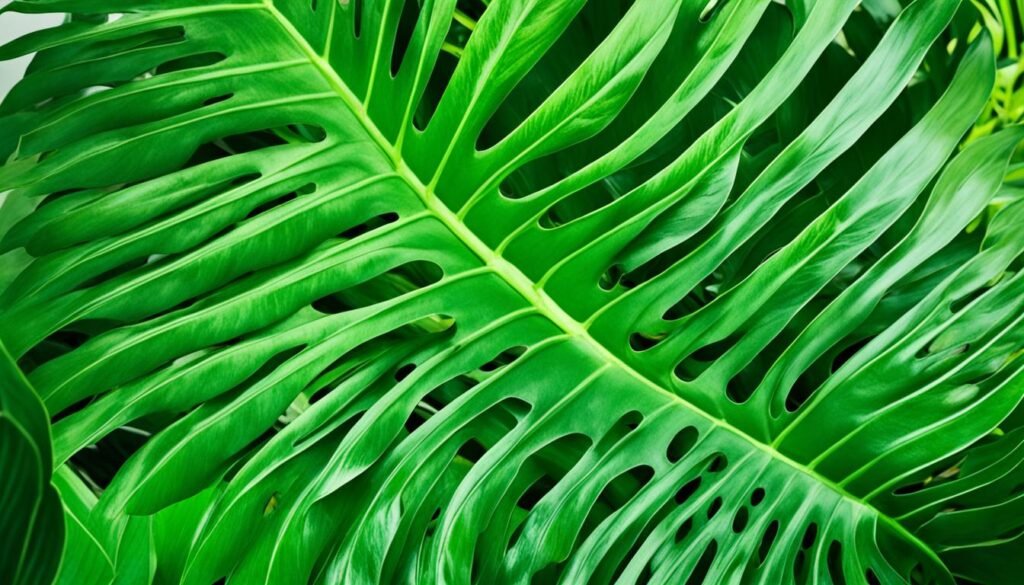
The Monstera’s large leaves create a striking visual impact and make it a standout piece in any interior design or garden. Its unique leaf structure, resembling Swiss cheese with its fenestrations, adds an intriguing touch to its overall charm.
Caring for a Monstera
When caring for a Monstera, it’s important to provide the ideal conditions for its growth:
- Place the plant in bright indirect light. Avoid direct sunlight, as it can scorch the leaves.
- Maintain moderate humidity levels by misting the leaves regularly or placing the plant in a humid environment.
- Water the Monstera when the top inch of soil feels dry, ensuring proper drainage to prevent waterlogged roots.
- Use a well-draining soil mix to promote healthy root development and prevent waterlogged conditions.
Remember to regularly clean the leaves to keep them dust-free and enable optimal photosynthesis. With proper care, the Monstera will continue to thrive and bring its unique beauty to your living space.
Heart-Leaf Philodendron: Easy-Care and Quick-Growing
The heart-leaf philodendron, also known as Philodendron hederaceum, is a versatile and popular plant among gardening enthusiasts. With its heart-shaped leaves and vibrant green foliage, it adds a touch of natural beauty to any space.
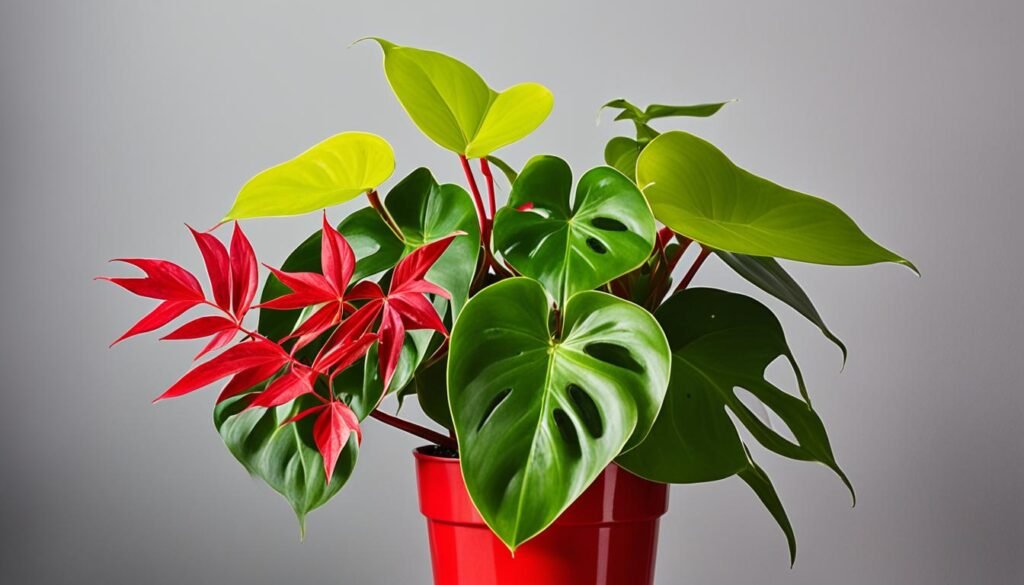
This climbing and trailing plant is not only visually appealing but also easy to care for. It is an excellent choice for both beginners and experienced gardeners looking for a low-maintenance addition to their collection.
To ensure the healthy growth of your heart-leaf philodendron, provide it with bright light. However, direct sunlight should be avoided as it can cause leaf burns. Indirect sunlight is ideal for this plant, making it suitable for various indoor environments.
Moderate humidity is beneficial for the heart-leaf philodendron and other tropical plants. Regular misting or placing the plant near a humidifier can help create an ideal growth environment.
Philodendrons are available in various cultivars, each offering unique characteristics. Whether you prefer compact varieties for small spaces or trailing cultivars for cascading elegance, there is a heart-leaf philodendron to suit every preference.
Other Stunning Plants with Heart-Shaped Red Foliage
In addition to the aforementioned plants, there are several other stunning options with heart-shaped red foliage. These include caladiums, begonias, and peace lilies. Caladium bicolor varieties like Florida Red Ruffles and Red Flash offer vibrant red leaves with wavy edges. Beleaf Begonia and Heart-Leaf Begonia are popular choices with red-pink heart-shaped leaves. These plants thrive in well-draining soil and require bright light or partial shade.
Caladiums, known for their colorful foliage, are a fantastic option for adding a pop of red to your garden. Their heart-shaped leaves come in various shades and patterns, making them visually striking. These plants prefer well-draining soil and should be placed in bright, indirect light or partial shade for optimum growth.
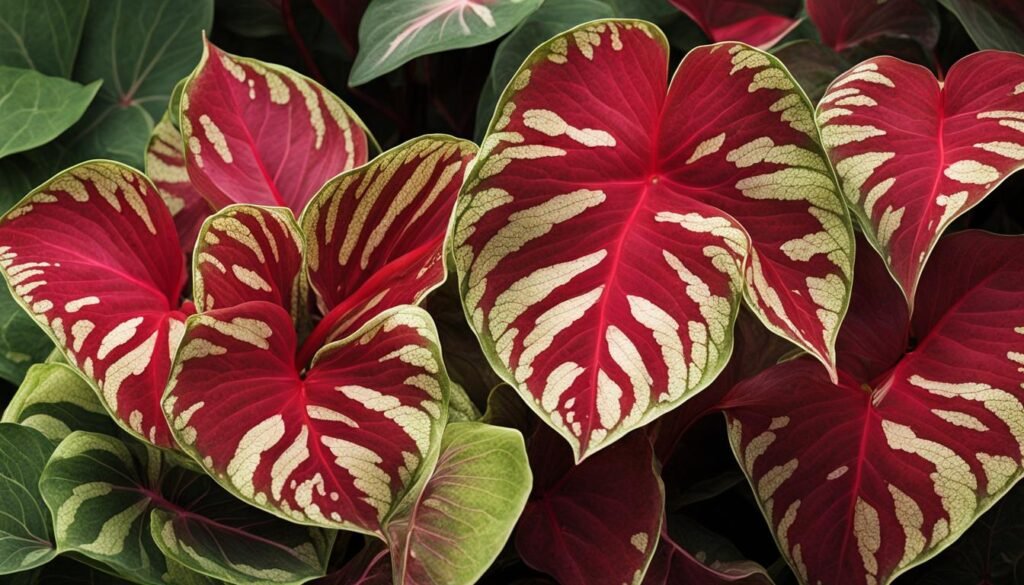
Begonias are another excellent choice if you’re looking for heart-shaped red foliage. Beleaf Begonia and Heart-Leaf Begonia both showcase captivating red-pink leaves that bring a touch of elegance to any space. These begonias thrive in well-draining soil and require moderate to bright light, making them versatile and adaptable houseplants.
Peace lilies, known for their graceful white flowers, also offer heart-shaped leaves with a twist of red. Their vibrant foliage adds a unique touch to any indoor setting. Peace lilies prefer well-draining soil and thrive in bright, indirect light or partial shade. Their ability to purify the air makes them an excellent choice for improving indoor air quality.
Maintaining a balanced level of moisture in the soil is crucial for these plants’ overall health and well-being. Regular watering, allowing the soil to dry out slightly between waterings, helps maintain their vibrant foliage.
When it comes to caring for these plants, it’s essential to keep in mind their specific light and moisture requirements. Paying attention to their needs will ensure they continue to thrive and bring beauty to your home or garden.
Considerations for Growing Plants with Heart-Shaped Red Leaves
When it comes to growing plants with heart-shaped red leaves, there are several important factors to consider. Proper care and attention will help ensure that these vibrant beauties thrive in your garden or indoor space. Let’s take a look at the key considerations for successfully growing and caring for plants with heart-shaped red leaves.
Lighting Requirements
Most plants with heart-shaped red leaves prefer bright but indirect light. This means placing them near a window where they can receive filtered sunlight. Avoid exposing them to direct sunlight as it can scorch their delicate foliage. If you’re growing these plants indoors, consider placing them in a room with ample natural light or using artificial grow lights to provide the necessary light intensity.
Watering Needs
Proper watering is essential for the health of plants with heart-shaped red leaves. These plants generally prefer moist soil, but it’s important not to overwater them. Before watering, check the top inch of soil for dryness. If it feels dry to the touch, it’s time to water. Use room temperature water and ensure that excess water drains out of the pot to prevent waterlogged roots.
Humidity Levels
Many plants with heart-shaped red leaves thrive in environments with moderate humidity levels. If your home or indoor space is dry, consider increasing humidity by placing a tray filled with water near the plants or using a humidifier. Another effective method is regular misting, which not only increases humidity but also helps prevent pests and dust accumulation on the foliage.
Soil Type
Choosing the right soil type is crucial for the success of these plants. They generally prefer well-draining soil that retains some moisture but doesn’t become waterlogged. A mixture of peat moss, perlite, and potting soil works well for most plants with heart-shaped red leaves. Avoid using heavy clay-based soils as they can lead to root rot.
Pruning
Regular pruning is essential for maintaining the shape and health of plants with heart-shaped red leaves. Remove any yellow or dead leaves, as well as any branches that are growing in an undesirable direction. Pruning also promotes new growth and helps the plant maintain its vibrant appearance. Use clean, sharp pruning tools to prevent the spread of disease.
Beginner-Friendly Plants
If you’re new to gardening or prefer low-maintenance plants, there are many heart-shaped red leaf varieties that are beginner-friendly. These plants are relatively easy to care for and forgiving when it comes to minor mistakes. Some popular beginner-friendly options include the arrowhead plant, heart-leaf philodendron, and string-of-hearts. These plants can withstand a range of growing conditions and require minimal intervention to thrive.
By considering these factors and providing the appropriate care, you can enjoy the beauty of plants with heart-shaped red leaves in your garden or indoor space. Whether you’re a seasoned gardener or just starting out, these stunning foliage plants are sure to add a touch of charm and vibrancy to any setting.
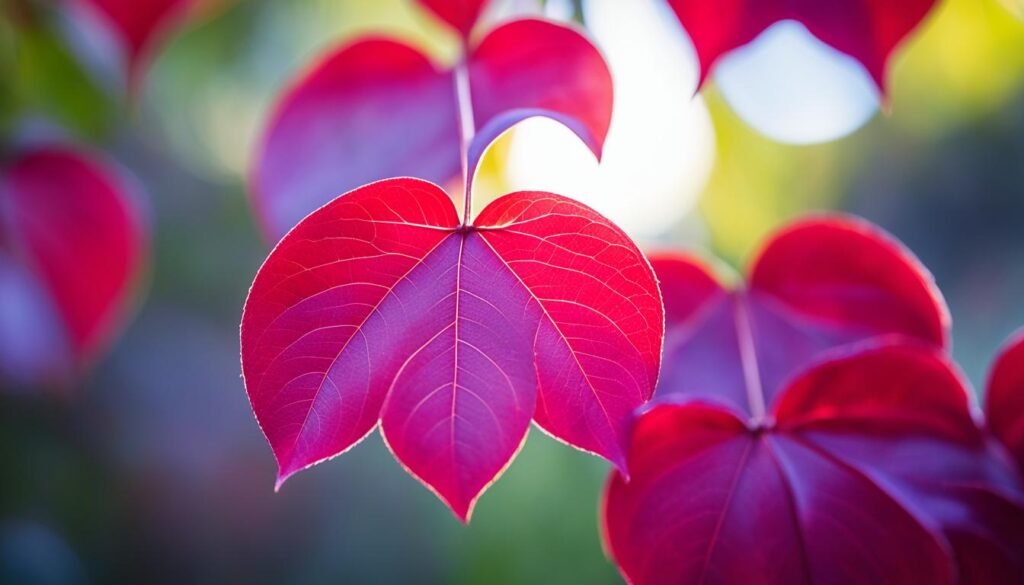
| Aspect | Considerations |
|---|---|
| Lighting Requirements | Prefer bright but indirect light Avoid direct sunlight to prevent leaf burns Consider artificial grow lights for indoor plants |
| Watering Needs | Moist soil, but avoid overwatering Check soil dryness before watering Ensure proper drainage |
| Humidity Levels | Moderate humidity preferred Increase humidity with trays of water or humidifiers Regular misting helps increase humidity |
| Soil Type | Well-draining soil Mixture of peat moss, perlite, and potting soil Avoid heavy clay-based soils |
| Pruning | Regular pruning maintains shape and health Remove yellow or dead leaves Prune branches growing in undesirable direction |
| Beginner-Friendly Plants | Arrowhead plant, heart-leaf philodendron, and string-of-hearts Tolerant of different growing conditions Require minimal maintenance |
Conclusion
Plants with heart-shaped red leaves bring a vibrant touch to any garden or indoor space. These stunning varieties, such as arrowhead plants, string-of-hearts, anthuriums, monsteras, and heart-leaf philodendrons, are sure to captivate you with their beauty. When given proper care and attention, these plants thrive and add a charming touch to your surroundings.
To ensure the well-being of these plants, it’s important to understand their specific care requirements. They generally prefer bright but indirect light, moist soil, and moderate humidity. Regular pruning helps maintain their shape and health. Whether you are a beginner or an experienced gardener, these plants are relatively easy to care for and will reward you with their vibrant foliage.
Whether you choose to showcase these plants outdoors in your garden or bring them inside as beautiful indoor plants, they are sure to be a stunning focal point. Explore the world of plants with heart-shaped red leaves and enjoy the beauty they bring to your surroundings. With their vibrant foliage, these plants are guaranteed to add a pop of color and a touch of nature to your space.
